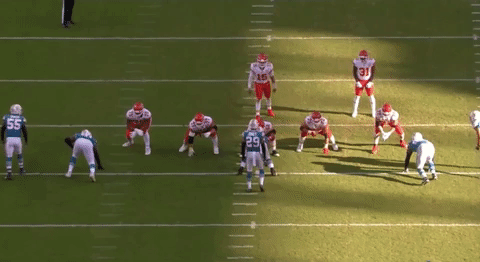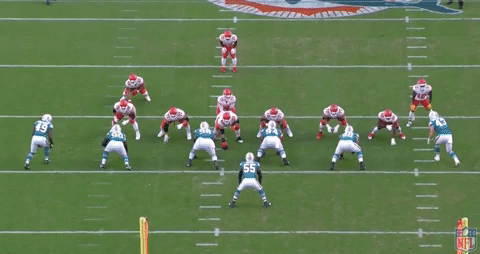The Chiefs top 3 tackles are out or limited. Now what?
Mitch Schwartz is out. Eric Fisher and Mike Remmers are missing practice. How can Kansas City adjust?
Having offensive line injuries is bad. Having offensive line injuries at similar positions is really bad. Having offensive line injuries to multiple people at similar positions is about as bad as it gets.
Unfortunately, that appears to be where the Chiefs are at heading into Sunday’s showdown with the New Orleans Saints.

The Chiefs have been blessed with good tackle play for multiple consecutive years now. Mitch Schwartz, until this season, hasn’t missed any significant time and has been arguably the best right tackle in the NFL. Fisher, though not on the same level as Schwartz, has been reliably solid as well as available.
Reid counts on both of his tackles to hold their own in pass protection for a lot of the empty sets the Chiefs like to run. With all the weapons at Patrick Mahomes’ disposal, spreading teams out with receivers all over the field is often the most efficient way to move the ball. That can only be done if the offensive line can keep him relatively clean for several seconds with only five blockers in.
On Sunday, the Chiefs are either going to be without their top three tackles OR Fisher and Remmers are going to be playing somewhat hurt. At this point in the season everyone is nursing an injury of some point, but it’s reasonable to believe that they might not be as effective as they have been.
If Remmers and Fisher can’t go, the Chiefs options are varied. They’ve used Yasir Durant as the 3rd string right tackle so far, and the results have not been terrific (which is to be expected with a rookie player who wasn’t supposed to be on the field at this point in his career).
The Chiefs have several other players who have experience at tackle. Andrew Wylie and Martinas Rankin have both, at times, been listed as or have practiced/played as tackles. Of course, Wylie is currently starting at right guard. But when you lose your top 3 tackles it’s emergency time.
One reason that Wylie could potentially be moved to left tackle in the event Fisher can’t play is that the Chiefs recently re-acquired Stefen Wisniewski, whose solid play at guard down the stretch last season helped solidify the interior offensive line. Frankly, Wisniewski outplayed Wylie by a wide margin last year, so moving him to right guard while Wylie goes outside (if that’s the plan) could actually benefit the interior.
Rankin hasn’t played in over a calendar year after suffering a patella injury, and it’s notable that when Remmers went down it wasn’t Rankin who was in line to replace him (after serving as a backup tackle and guard last season before his injury). It remains to be seen if he’ll be on the field, but I find it relatively if he wasn’t already the backup considering his previous solid play and the fact that Durant doesn’t look ready for action yet.
Regardless of whether it’s Durant/Wylie or Rankin/Wylie or Rankin/Durant, the line will be hindered Sunday. That’s likely the case even if Remmers and Fisher play hurt. So what are the Chiefs to do, especially with the terrifying Cam Jordan and Saints pass rush coming to town?
The better question is to break things down in a different way: What should the Chiefs do if the pass protection, particularly along the edges, can’t hold up? And fortunately, we’ve seen this happen in just enough games to have something of an answer.
In the Super Bowl last season, while Schwartz was dominant, Fisher was beaten repeatedly by Nick Bosa (there’s no shame in that) while the interior struggled to hold up against Buckner (again, that’s going to happen). We’ve also seen several weeks this year where the line struggled to protect Mahomes, such as Week 2 against the Chargers and their loss against the Raiders.
So while the injury issues are new, it’s not like the Chiefs have never had to gameplan or adjust to pressure on Mahomes. And unless one of the backups (or an unexpectedly healthy tackle duo) is able to surprise on Sunday, the answer for the Chiefs will be in scheme rather than players.
One thing the Chiefs have done to adjust to pressure issues as the season has moved along is move the pocket, which can throw off pass rushes and gets Mahomes in space. One such example came on the 44-yard Mahomes-to-Hill touchdown against Miami.
This is a shot play protection that Reid has dialed up repeatedly since 2018, utilizing a tight end (often Kelce, who can hold defenders near the line of scrimmage with his mere presence and is an underrated blocker) to hold off a defensive end while Mahomes rolls out. Notice the line all moves left to sell play action, which slows down the rush as well. Kelce is able to contain a good rusher in Emmanuel Ogbah long enough for Hill to get down the field, and the Chiefs collect six.
Moving the pocket is a simple way to compensate for pressure by removing several pass rushers from contention. It allows offensive linemen to have a natural advantage of walling off one direction rather than trying to protect a pocket, and the distance created between Mahomes and defenders buys time for Mahomes to survey the field.
Because Mahomes is capable of making reads and throws while on the run rolling either direction, the Chiefs have an advantage over any team in the league in terms of being able to run looks like this consistently without poor throws being risked. It’s something they’ve used quite a bit over the last few weeks in the red zone and on important downs, such as their final third down conversion against the Buccaneers.
The (usual) downside to rollouts are several: They can expose the quarterback to very fast pressure if the edges anticipate it, it makes for harder throws, and it cuts the field in half for the quarterback as well as shrinking room for receivers.
Fortunately for the Chiefs, their unique personnel (Mahomes and multiple extremely smart route runners) and Andy Reid allow them to largely negate most of those issues. It’s the fear of quick pressure that is tough to account for. If the Chiefs are going to utilize this, they should roll away from Jordan early and often.
Another thing the Chiefs can do is utilize a similar game plan to what they did in the second Raiders game, consistently spreading the defense out and utilizing a series of dink and dunk throws to get the ball out before the pass rush had time to get home.
The Chiefs like to combine their quick passing game with shot plays baked in, so that if Mahomes sees something he likes or the protection holds up better than expected they can still try to take the top off the defense while having multiple options for the ball to come out in under two seconds. The Chiefs did this in the second half with frequency against the Chargers in Week 2 after the line struggled to keep Mahomes clean and he started struggling with happy feet. Quickening the throws helped them get back into a rhythm. They also combine these quick throws/routes with the run/pass options to keep defenses on their toes.
Do you like what you’re reading? If you’re not a subscriber, just know you’re missing out on multiple articles like this each and every week. Click below to subscribe for 60% off (12 bucks a year) FOREVER. Seriously, why wouldn’t you?
Play action and RPO’s will be critical if the Chiefs are short on blockers (or have blockers playing hurt) in order to keep the rushers honest. For that to be most effective, they’ll want to at least present the threat of running the ball (while you don’t need to run effectively to make play action effective, you want the threat to be there). It wouldn’t surprise me if they came out early testing the Saints’ run defense to try and set up looks later in the game.
Another thing the Chiefs can do to slow down the edge rushers is utilize their extensive sweep looks, whether it’s via handoff or touch pass. These plays can penalize edge rusher for looking to get up the field rather than contain the edge as well as result in big plays in space.
What plays like this can do is create doubt in the future, as players on the edge will need to hesitate for a split second before starting their rush. The Chiefs out to threaten this action multiple times Sunday to force New Orleans’ talented rushers to pause and give their tackles an advantage.
We’ll see who the Chiefs suit up at tackle on Sunday and how effective they are, but one thing that’s important to remember is that this isn’t the first time the Chiefs have had to account for the pass rush being too much for the offensive line. They have a number of options to account for it, and by utilizing some of the pieces already in the offense a bit more they ought to be able to at least give Mahomes a chance to do what he does so well.








Great stuff as always. Do you think the screen game gets utilized more this week as another tool to slow the pass rush down? I don't remember seeing very many screens of late but they have been a staple in Andy Reid's offense over the last few years. I would imagine like anything else that teams are scouting them better and recognizing faster but I feel like some new wrinkles in the screen game could help out a beat up offensive line.
I must admit I haven't watched the Saints much this year - how much does Jordan move around? Does he line up always to the defensive right? That would sure make it easier to game plan for him in particular. The Saints defense and their approach seems a lot like the Chargers, who have done well and improved with each look they've gotten at Mahomes. But one of the Chief's hopes is that they get the advantage from this defense seeing this speed for the first time. That's been a real plus in a couple of recent games - Tampa in particular, but also Miami - where our speed overwhelmed their scheme and forced them into adjustments after the game had already swung in a major way.
Good analysis as always! This is my best-spent $12 of 2020.